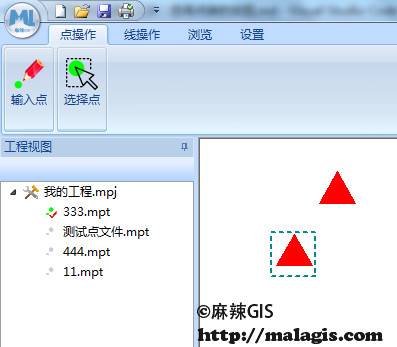VC++开发GIS系统(128)选择点类的实现
发布时间: 2016-01-12
所属分类: VC++开发GIS系统
前文《VC++开发GIS系统(127)选择点类的设计》中已经对选择点做了一个定义,本文介绍实现的代码:
代码实现
/*
* 选择点实现
*/
malaPoint CmalaPointsSelect::m_pnt;
malaPointPro CmalaPointsSelect::m_PntPro;
CView* CmalaPointsSelect::m_StaticView = NULL;
malaScreen* CmalaPointsSelect::m_Screen = NULL;
CmalaPointsSelect::CmalaPointsSelect()
{
}
CmalaPointsSelect::CmalaPointsSelect(CView* mView, malaScreen *pScreen, CString &fileFullPath)
{
mBaseView = mView;
m_StaticView = mView;
mPath = fileFullPath;
m_bDraw = FALSE;
m_Selected = FALSE;
m_Screen = pScreen;
}
CmalaPointsSelect::~CmalaPointsSelect()
{
}
void CmalaPointsSelect::LButtonDown(UINT nFlags, malaPoint point)
{
m_bDraw = TRUE;
m_ptOrigin = m_perPoint = point;
}
void CmalaPointsSelect::LButtonUp(UINT nFlags, malaPoint point)
{
m_bDraw = FALSE;
malaCDC dc(mBaseView, *m_Screen);
dc.drawRectNULLFill(m_ptOrigin, point);
if (m_ptOrigin.x > point.x)
{
m_rect.xmax = m_ptOrigin.x;
m_rect.xmin = point.x;
}
else
{
m_rect.xmin = m_ptOrigin.x;
m_rect.xmax = point.x;
}
if (m_ptOrigin.y > point.y)
{
m_rect.ymax = m_ptOrigin.y;
m_rect.ymin = point.y;
}
else
{
m_rect.ymin = m_ptOrigin.y;
m_rect.ymax = point.y;
}
//先获取所有符合条件的点
CPointIO pio;
vector<malaPointFile>allPoints;
pio.getAllPoint(*m_Screen, allPoints, mPath);
//再查找是否被选中
malaLogic tlog;
for (size_t j = 0; j < allPoints.size(); j++)
{
if (tlog.isPntInRect(allPoints[j].m_point, m_rect))
{
m_pnt = allPoints[j].m_point;
m_PntPro = allPoints[j].m_pointpro;
CPoint A, B;
A.x = long(m_pnt.x - m_PntPro.pointRadio);
A.y = long(m_pnt.y - m_PntPro.pointRadio);
B.x = long(m_pnt.x + m_PntPro.pointRadio);
B.y = long(m_pnt.y + m_PntPro.pointRadio);
SetTimer(mBaseView->m_hWnd, 1, 500, TimerProc);
if (MessageBox(mBaseView->m_hWnd, L"选择该点吗?", L"提示", MB_YESNO | MB_ICONQUESTION) == IDYES)
{
KillTimer(mBaseView->m_hWnd, 1);
mBaseView->InvalidateRect(CRect(A, B), TRUE);
malaCDC dc(mBaseView,*m_Screen);
dc.drawSelectRectPoint(m_pnt, m_PntPro);
m_Selected = TRUE;
break;
}
KillTimer(mBaseView->m_hWnd, 1);
mBaseView->InvalidateRect(CRect(A, B), TRUE);
}
}
}
void CmalaPointsSelect::MouseMove(UINT nFlags, malaPoint point)
{
if (m_bDraw)
{
malaCDC dc(mBaseView, *m_Screen);
dc.drawRectNULLFill(m_ptOrigin, m_perPoint);
dc.drawRectNULLFill(m_ptOrigin, point);
m_perPoint = point;
}
}
代码解析
因为定义了静态变量,所以在类的实现的时候需要先赋值
malaPoint CmalaPointsSelect::m_pnt;
malaPointPro CmalaPointsSelect::m_PntPro;
CView* CmalaPointsSelect::m_StaticView = NULL;
malaScreen* CmalaPointsSelect::m_Screen = NULL;
关于静态变量,推荐参考:C++中Static作用和使用方法。这里实现的橡皮筋绘图和放大地图中所用的一致,可以参考:VC++开发GIS系统(110)放大地图之简析橡皮筋绘图。
这里比较关键的是在LButtonUp的时候,先获取当前所有的点,并遍历所有的点。如果点在所拉矩形框中(用到了isPntInRect函数,参考:VC++开发GIS系统(93)窗口的重绘(三)),使用SetTimer,每隔500ms调用一次函数TimerProc,实现点的闪烁。如果是要选中的点,则使用KillTimer关闭闪烁,并使用InvalidateRect实现局部刷新,不必全部重绘,然后使用drawSelectRectPoint函数在选中点周围做一个标记。代码如下:
/*
* 绘制选中状态的外接矩形
*/
void malaCDC::drawSelectRectPoint(malaPoint Point, malaPointPro PntPro)
{
PntPro.pointRadio++;
CClientDC dc(mView);
LOGBRUSH log;
log.lbColor = RGB(0 ,139, 139);
log.lbStyle = BS_SOLID;
CPen pen(PS_GEOMETRIC | PS_DASH, 2, &log);
CPen* OldPen = dc.SelectObject(&pen);
CPoint Point1, Point2;
CoordToScreen(Point.x - PntPro.pointRadio, Point.y + PntPro.pointRadio, mScreen, &Point1.x, &Point1.y);
CoordToScreen(Point.x + PntPro.pointRadio, Point.y - PntPro.pointRadio, mScreen, &Point2.x, &Point2.y);
dc.Rectangle(CRect(Point1, Point2));
dc.SelectObject(OldPen);
}
效果如下:

详细代码可以参考:GitHub
相关阅读
声明
1.本文所分享的所有需要用户下载使用的内容(包括但不限于软件、数据、图片)来自于网络或者麻辣GIS粉丝自行分享,版权归该下载资源的合法拥有者所有,如有侵权请第一时间联系本站删除。
2.下载内容仅限个人学习使用,请切勿用作商用等其他用途,否则后果自负。
手机阅读
公众号关注
知识星球
手机阅读

最新GIS干货

私享圈子











































